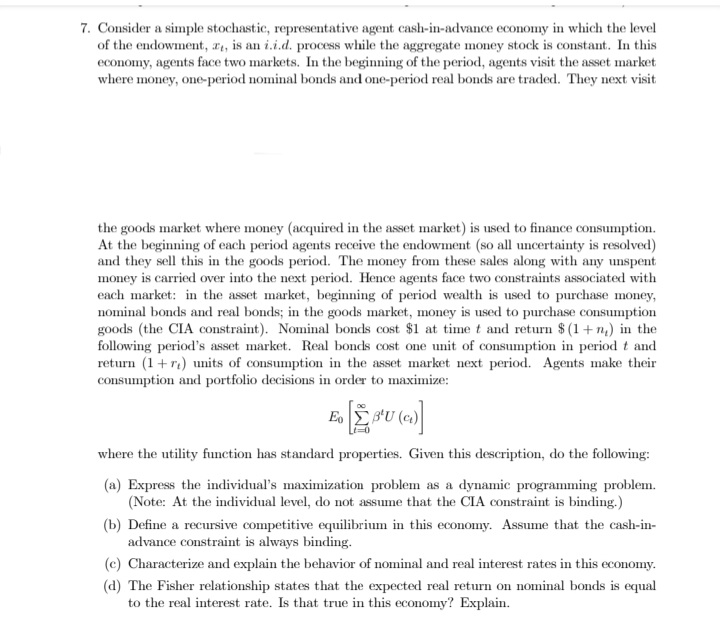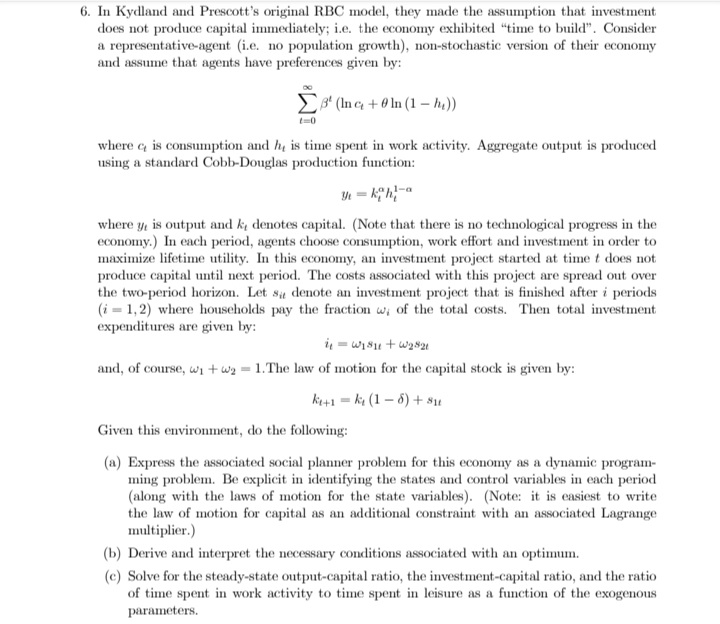

am stuck please help
7. Consider a simple stochastic, representative agent cash-in-advance economy in which the level of the endowment, It, is an i.i.d. process while the aggregate money stock is constant. In this economy, agents face two markets. In the beginning of the period, agents visit the asset market where money, one-period nominal bonds and one-period real bonds are traded. They next visit the goods market where money (acquired in the asset market) is used to finance consumption. At the beginning of each period agents receive the endowment (so all uncertainty is resolved) and they sell this in the goods period. The money from these sales along with any unspent money is carried over into the next period. Hence agents face two constraints associated with each market: in the asset market, beginning of period wealth is used to purchase money, nominal bonds and real bonds; in the goods market, money is used to purchase consumption goods (the CIA constraint). Nominal bonds cost $1 at time t and return $ (1 + n,) in the following period's asset market. Real bonds cost one unit of consumption in period t and return (1 + r,) units of consumption in the asset market next period. Agents make their consumption and portfolio decisions in order to maximize: Bo BU ( C ) where the utility function has standard properties. Given this description, do the following: (a) Express the individual's maximization problem as a dynamic programming problem. (Note: At the individual level, do not assume that the CIA constraint is binding.) (b) Define a recursive competitive equilibrium in this economy. Assume that the cash-in- advance constraint is always binding (c) Characterize and explain the behavior of nominal and real interest rates in this economy. (d) The Fisher relationship states that the expected real return on nominal bonds is equal to the real interest rate. Is that true in this economy? Explain.6. In Kydland and Prescott's original RBC model, they made the assumption that investment does not produce capital immediately; i.e. the economy exhibited "time to build". Consider a representative-agent (i.e. no population growth), non-stochastic version of their economy and assume that agents have preferences given by: Es' (Ina + 0In (1 - h)) 1=0 where o is consumption and h, is time spent in work activity. Aggregate output is produced using a standard Cobb-Douglas production function: hi-a where y, is output and &, denotes capital. (Note that there is no technological progress in the economy.) In each period, agents choose consumption, work effort and investment in order to maximize lifetime utility. In this economy, an investment project started at time f does not produce capital until next period. The costs associated with this project are spread out over the two-period horizon. Let sy denote an investment project that is finished after i periods (i = 1,2) where households pay the fraction w; of the total costs. Then total investment expenditures are given by: 1 = Wight + w2821 and, of course, wj + w2 - 1. The law of motion for the capital stock is given by: kit1 = ki (1 - 6) + $1 Given this environment, do the following: (a) Express the associated social planner problem for this economy as a dynamic program- ming problem. Be explicit in identifying the states and control variables in each period (along with the laws of motion for the state variables). (Note: it is easiest to write the law of motion for capital as an additional constraint with an associated Lagrange multiplier.) (b) Derive and interpret the necessary conditions associated with an optimum. (c) Solve for the steady-state output-capital ratio, the investment-capital ratio, and the ratio of time spent in work activity to time spent in leisure as a function of the exogenous parameters










